Level Up Your Marketing with Mailchimp Integrations
Want to maximize your Mailchimp effectiveness? This list of top Mailchimp integrations will help you streamline your marketing efforts and boost your ROI. Discover how these tools solve common marketing challenges, from automating workflows and syncing data to personalizing campaigns and improving lead generation. We'll cover key integrations like OKZest, Zapier, Integromat (Make), HubSpot, WooCommerce, Salesforce, Gravity Forms, and Shopify, empowering you to make the most of your Mailchimp account.
1. OKZest
Boost your Mailchimp integrations and email marketing ROI with OKZest, a powerful no-code platform that lets you create personalized images at scale. Forget generic email blasts; OKZest empowers you to generate dynamic visuals tailored to each recipient, significantly increasing engagement and driving conversions. Imagine sending welcome emails with personalized onboarding images, promotional offers featuring individual discount codes embedded directly into the graphic, or event reminders displaying the attendee's name and a unique QR code. This level of personalization is now easily achievable with OKZest's seamless integration with Mailchimp.
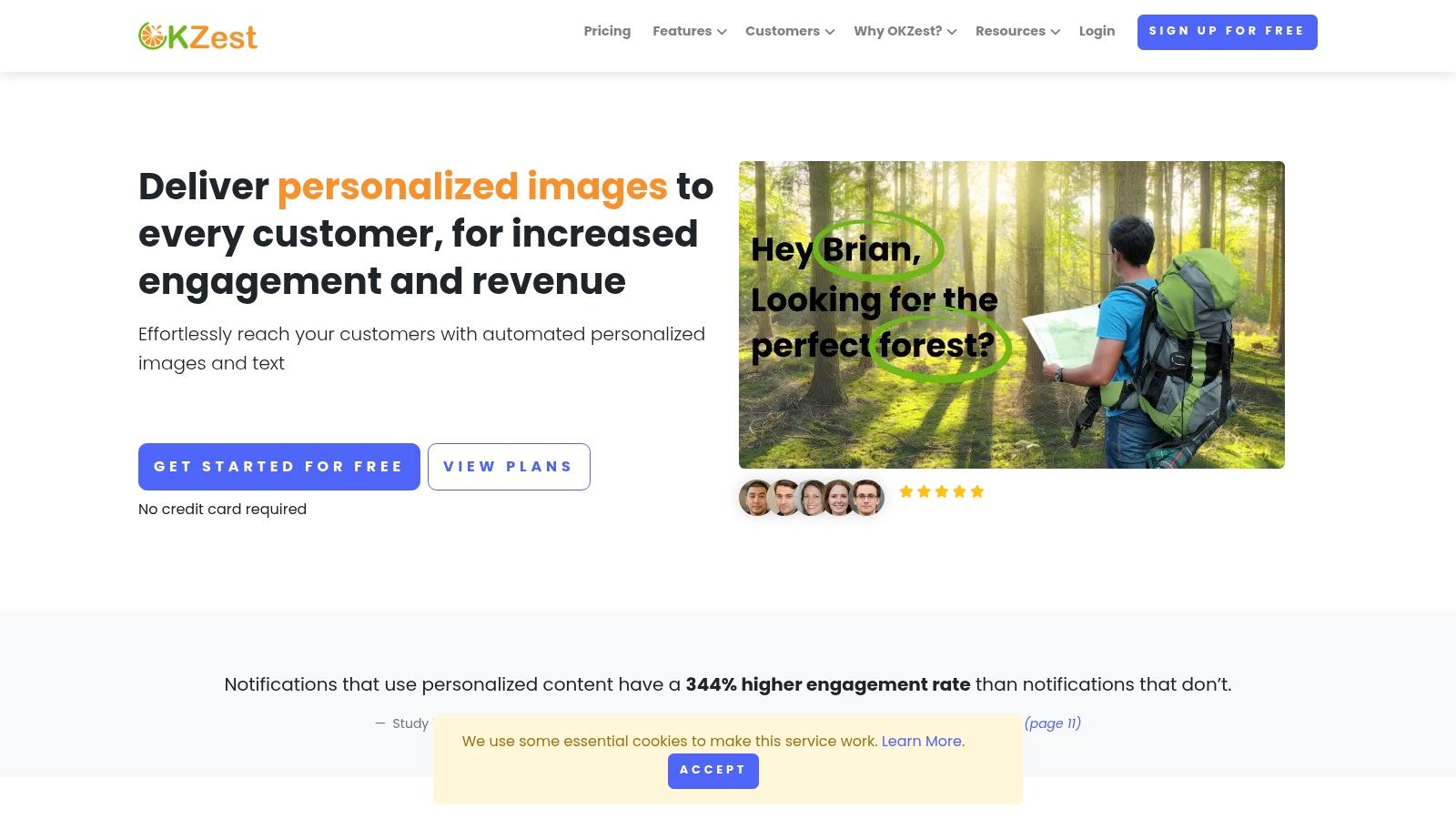
For email marketers seeking a competitive edge, OKZest stands out among Mailchimp integrations. By leveraging merge tags, similar to how you personalize text in your emails, OKZest dynamically populates images with both static and real-time data pulled from your databases or APIs. This means you can create truly unique visuals featuring personalized names, company logos, product recommendations based on past purchases, location-specific information, and much more. Learn more about OKZest and its API capabilities. This personalized approach helps capture attention in crowded inboxes and strengthens customer relationships, leading to higher click-through rates and ultimately, increased revenue. Studies show that personalized notifications drive 344% higher engagement, proving the effectiveness of this strategy.
OKZest boasts compatibility with 99% of Email Service Providers, including not just Mailchimp, but also popular platforms like Klaviyo and Instantly, ensuring flexibility and broad application. Its flexible pricing structure caters to businesses of all sizes, from startups leveraging the generous free forever plan (offering 2,500 images per month) to large enterprises requiring millions of images, handled by their enterprise-level packages. Advanced team features like role management and project assignment (available on higher-tier plans) streamline collaboration for marketing agencies and larger teams. Furthermore, OKZest provides robust support options, including real-time text and video chat, ensuring you get the assistance you need to maximize the platform's potential.
Pros:
- Enables highly personalized images using both static and dynamic data sources for individualized communication.
- Compatible with 99% of Email Service Providers, including popular platforms like Mailchimp and Klaviyo.
- Flexible pricing tiers from a generous free plan to enterprise solutions accommodating millions of images per month.
- Built-in team collaboration features including role-based permissions and project management.
- Excellent customer support with real-time chat and video calls to help users maximize value.
Cons:
- Some advanced features, such as project management, are only available on higher-tier plans.
- Personalization effectiveness depends on the quality and availability of dynamic data sources.
OKZest earns its place on this list of essential Mailchimp integrations due to its innovative approach to visual personalization. Its ability to seamlessly integrate with Mailchimp, combined with powerful features and flexible pricing, makes it an invaluable tool for any business aiming to elevate its email marketing game and forge stronger customer connections through visually engaging, personalized content. Visit the OKZest website to explore its features and pricing plans in detail.
2. Zapier
Zapier is a leading automation platform that seamlessly integrates Mailchimp with over 5,000 other applications, empowering users to create automated workflows, known as "Zaps," without any coding expertise. This makes it an invaluable tool for streamlining various marketing tasks and boosting overall efficiency. For instance, imagine automatically adding new leads captured from a Facebook Lead Ad directly to your Mailchimp audience. Or perhaps you want to trigger a targeted email campaign based on a customer's purchase in your eCommerce store. Zapier makes these scenarios, and countless others, a reality, making it one of the most powerful Mailchimp integrations available.
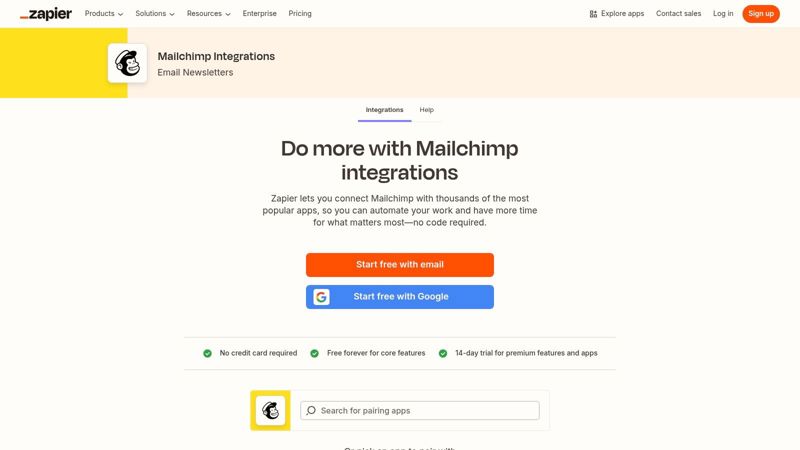
Zapier offers a visual workflow builder with pre-built templates, making setup incredibly user-friendly. You can create multi-step Zaps for complex automation flows, incorporating filters and conditional logic to ensure targeted actions. For example, you could set up a Zap that adds new subscribers to a specific Mailchimp segment based on their responses in a lead capture form. This level of granularity allows for highly personalized email marketing strategies. Moreover, Zapier offers robust error handling and notifications, ensuring reliable performance and keeping you informed about your automation processes. Learn more about Zapier and other email marketing best practices. This can be particularly beneficial for email marketers seeking to optimize their campaigns and streamline workflows.
For busy professionals like social media managers, event organizers, and consultants, Zapier's ability to synchronize Mailchimp with CRMs and other business tools is a game-changer. Imagine automatically updating contact information across platforms, eliminating manual data entry and ensuring consistency. This interconnectivity is a huge advantage for marketing agencies managing multiple client accounts, allowing them to scale their efforts and deliver better results.
Features:
- 5,000+ app integrations with Mailchimp
- Visual workflow builder with templates
- Multi-step Zaps for complex automation flows
- Filters and conditional logic for targeted actions
- Error handling and notifications
Pros:
- No coding required for integration setup
- Extensive app ecosystem
- Flexible automation capabilities
- Reliable performance with monitoring
Cons:
- Free plan limited to 5 single-step Zaps
- Premium features require paid plans (starting at $19.99/month)
- Complex workflows can get expensive
- Some actions count as multiple tasks against quota
Website: https://zapier.com/apps/mailchimp/integrations
Zapier deserves its place on this list because it bridges the gap between Mailchimp and a vast network of applications, allowing for unprecedented automation possibilities. Its user-friendly interface, combined with powerful features, makes it a valuable asset for anyone looking to enhance their Mailchimp integrations and optimize their marketing workflows. Whether you're a sales team looking to automate lead nurturing or an influencer marketer aiming to segment your audience based on engagement, Zapier offers a flexible and scalable solution. While the free plan has limitations, the investment in a paid plan can significantly enhance your Mailchimp experience and ultimately save you time and resources.
3. Integromat (Make)
Integromat, now known as Make, stands out among Mailchimp integrations for its robust automation capabilities and visual workflow builder. This platform empowers you to create complex integrations between Mailchimp and hundreds of other applications, offering significantly more flexibility than many competitors. Make excels in intricate scenarios, incorporating branching, aggregation, and data transformations, making it ideal for businesses requiring granular control over their Mailchimp data flows and automated processes. This level of control is invaluable for Mailchimp integrations, allowing for highly customized and efficient workflows.
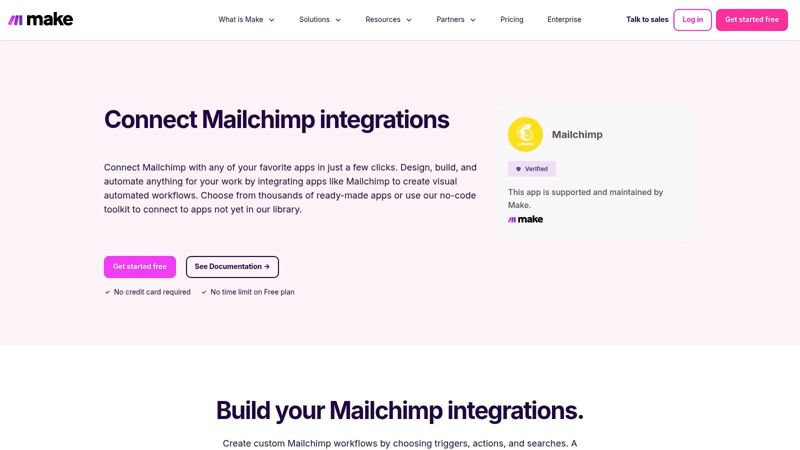
For instance, imagine you're an event organizer using Mailchimp to manage attendee registrations. With Make, you can automate a multi-step workflow: when someone registers through a form linked to Mailchimp, Make can automatically add them to a Google Sheet, send a personalized welcome email with event details, and even register them for a webinar platform – all without manual intervention. This is just one example of how Make's sophisticated scenarios streamline processes and save valuable time. Compared to simpler tools like Zapier, Make's visual builder provides a more comprehensive approach to Mailchimp integrations, although it does come with a steeper learning curve.
Features:
- Visual scenario builder with advanced routing options
- Data transformation and manipulation tools
- Error handling with automatic retries
- Webhooks for custom integrations
- Real-time execution with detailed logs
Pros:
- More affordable than Zapier for similar operational volumes, making it a budget-friendly option for scaling your automation needs.
- Greater flexibility in data handling and transformations, allowing for intricate workflows and customized data manipulation within your Mailchimp integrations.
- Lower operation consumption model, offering more value for your investment.
- Unlimited scenarios on all plans, providing scalability for your automation strategy.
Cons:
- Steeper learning curve than simpler tools. While the visual interface is powerful, it takes time to master.
- Free plan limited to 1,000 operations. This might be restrictive for users with high-volume needs.
- Interface can be overwhelming for beginners. The extensive features can feel daunting initially.
- Smaller app directory than Zapier. Although Make integrates with hundreds of apps, Zapier boasts a larger selection.
Pricing: Make offers a free plan with limited operations, and paid plans start at a competitive price point, offering progressively more operations and features as you scale. Specific pricing can be found on their website.
Implementation Tips:
- Start with a simple scenario to familiarize yourself with the interface. Make's tutorials and documentation are excellent resources.
- Utilize the data transformation tools to customize how data is passed between Mailchimp and other applications.
- Explore the error handling features to ensure robust and reliable automations.
Make's powerful visual builder and flexible automation capabilities make it a valuable asset for those seeking advanced control over their Mailchimp integrations. While the learning curve is steeper than simpler alternatives, the ability to create complex, customized workflows justifies its place on this list, particularly for businesses with intricate automation requirements. Visit the Make website (https://www.make.com/en/integrations/mailchimp) to explore its features and integrations in more detail.
4. HubSpot
For businesses heavily reliant on HubSpot's CRM, integrating it with Mailchimp's email marketing platform is a game-changer. This powerful native integration connects HubSpot's rich customer data with Mailchimp's robust email capabilities, creating a closed-loop marketing and sales ecosystem. This allows for highly targeted email campaigns driven by granular CRM data, while simultaneously tracking email engagement back in HubSpot for a comprehensive view of customer interactions. This integration deserves its place on this list due to its ability to streamline workflows and provide detailed analytics across both platforms, ultimately boosting marketing ROI.
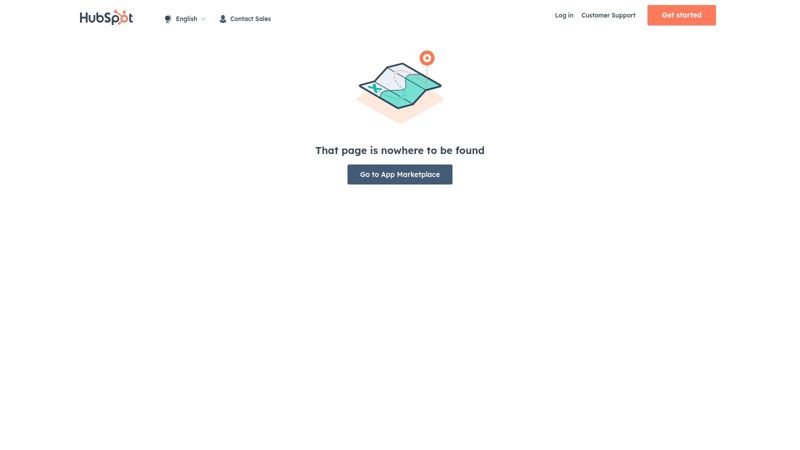
Imagine segmenting your Mailchimp audience based on HubSpot lifecycle stages, deal progress, or specific contact properties. You could send targeted email nurturing campaigns to leads who have downloaded a specific resource, automatically update contact lists based on CRM activities like deal closures, or trigger automated welcome emails when a new contact is added in HubSpot. This streamlines the marketing-to-sales handoff and provides valuable context for sales teams. For instance, a sales representative can see a lead's email engagement history directly within HubSpot before reaching out, leading to more personalized and effective communication. You can Learn more about HubSpot and its email marketing capabilities.
Features:
- Bi-directional contact synchronization: Keeps your contacts consistent across both platforms.
- Campaign performance tracking in HubSpot: Analyze email opens, clicks, and conversions within your CRM.
- Segment creation based on HubSpot data: Target specific customer segments with tailored messaging.
- Automatic list updates based on CRM activities: Dynamically manage your Mailchimp lists based on real-time HubSpot data.
- Unified customer view across platforms: Gain a 360-degree view of your customer interactions.
Pros:
- Deep native integration without third-party tools: Simplifies setup and reduces reliance on external connectors.
- Combined power of leading CRM and email marketing platforms: Leverages the strengths of both HubSpot and Mailchimp.
- Streamlined marketing-to-sales handoff: Provides sales teams with valuable insights into lead engagement.
- Detailed performance analytics: Track campaign performance across both platforms to optimize your marketing efforts.
Cons:
- Full functionality requires HubSpot paid plans: Limits access for users on free HubSpot accounts. Some advanced features, like granular segmentation, are tied to higher-tier HubSpot subscriptions.
- Some advanced features limited to higher-tier plans: Access to the full suite of integration capabilities requires investment in premium HubSpot plans.
- Initial setup can be complex: Proper configuration requires careful mapping of data fields between the two platforms.
- Potential contact duplication issues: Requires diligent setup and monitoring to prevent creating duplicate contact records.
Website: https://ecosystem.hubspot.com/marketplace/apps/marketing/email-marketing/mailchimp
Implementation Tip: Before implementing this integration, meticulously map your HubSpot contact properties to your Mailchimp audience fields to ensure seamless data synchronization and avoid discrepancies. Consider starting with a smaller test segment before syncing your entire contact database to identify and resolve any potential issues. Thorough planning and testing are crucial for a successful integration. This integration is highly beneficial for email marketers seeking to leverage their CRM data for targeted email campaigns and streamline their marketing-to-sales processes. However, it's essential to carefully consider the pricing and technical requirements before implementation. This ensures that the integration aligns with your budget and technical capabilities.
5. WooCommerce Mailchimp Integration
For e-commerce businesses using WooCommerce, integrating their store with their email marketing platform is crucial for maximizing sales and customer engagement. The WooCommerce Mailchimp Integration, an official plugin, offers a powerful connection between these two platforms, making it a top choice among Mailchimp integrations. This integration streamlines your workflow by automatically syncing vital customer data, purchase history, and even shopping behavior. This rich data allows for advanced email marketing automation based on real e-commerce activities, taking your marketing efforts to the next level.
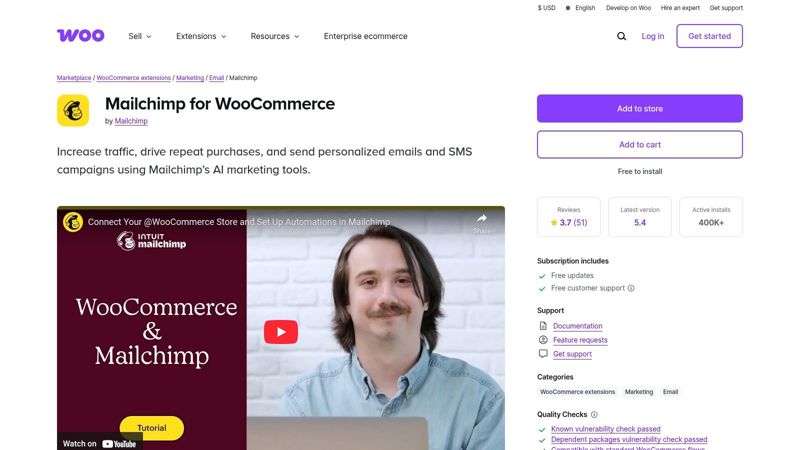
This integration is particularly beneficial for leveraging the power of personalized email marketing. Imagine automatically recovering abandoned carts with targeted emails reminding customers of the items they left behind. Or sending product recommendations based on previous purchases, enticing customers to return for more. With purchase-based segmentation, you can tailor your campaigns to specific customer groups based on their buying habits. This targeted approach allows for highly effective email marketing that resonates with your audience and boosts conversion rates. Furthermore, revenue attribution tracking lets you clearly see the impact of your email campaigns on your bottom line.
Key features of this integration include automated e-commerce data synchronization, abandoned cart recovery emails, product recommendation automations, purchase-based segmentation, and revenue attribution tracking. This makes it an all-in-one solution for e-commerce businesses looking to leverage the power of email marketing. This positions it as an invaluable tool for email marketers, marketing agencies, and anyone managing an online store. Consultants and coaches with clients running e-commerce businesses can also leverage this integration to provide enhanced marketing services.
Pros:
- Free plugin: The plugin itself is free to install and use, making it accessible to businesses of all sizes.
- Deep eCommerce data integration: Access a wealth of customer data to create highly targeted campaigns.
- Seamless WooCommerce store connection: The official plugin ensures a smooth and reliable connection between your WooCommerce store and Mailchimp.
- Real-time data synchronization: Keep your data up-to-date for accurate campaign targeting.
Cons:
- Requires Mailchimp paid plan: While the plugin is free, you will need a paid Mailchimp plan to access the full suite of eCommerce features.
- Can impact site performance: With large volumes of data, synchronization can sometimes impact website performance.
- Limited customization for data mapping: Flexibility in mapping specific data fields could be improved.
- Occasional sync delays during high traffic: During peak traffic periods, there might be occasional delays in data synchronization.
Implementation Tips:
- Install the WooCommerce Mailchimp plugin directly from your WordPress dashboard.
- Connect your Mailchimp account to the plugin.
- Configure your synchronization settings, including which data points to sync and how often.
- Set up your abandoned cart recovery emails and product recommendation automations.
- Segment your audience based on purchase behavior to create targeted campaigns.
This powerful integration justifies its place on this list due to its deep integration with WooCommerce, automation capabilities, and ability to drive significant results for e-commerce businesses. While a paid Mailchimp plan is required for full functionality, the free plugin and its core features provide considerable value. By leveraging the WooCommerce Mailchimp Integration, online businesses can significantly enhance their email marketing efforts and drive sales growth through personalized and automated campaigns. Download the plugin from the official WooCommerce website: https://woocommerce.com/products/mailchimp-for-woocommerce/
6. Salesforce Mailchimp Integration
For businesses heavily reliant on Salesforce as their CRM, integrating it with Mailchimp's email marketing prowess can significantly enhance marketing and sales alignment. The Salesforce Mailchimp Integration bridges the gap between these two powerful platforms, enabling a seamless flow of data and insights. This integration empowers businesses to synchronize contact data, track campaign performance across both systems, and gain a holistic view of the customer journey. Marketing teams can leverage rich Salesforce data to segment audiences and personalize Mailchimp campaigns, while sales teams benefit from seeing email engagement directly within Salesforce, informing their outreach and follow-up strategies. This makes it a valuable addition to our list of top Mailchimp integrations.
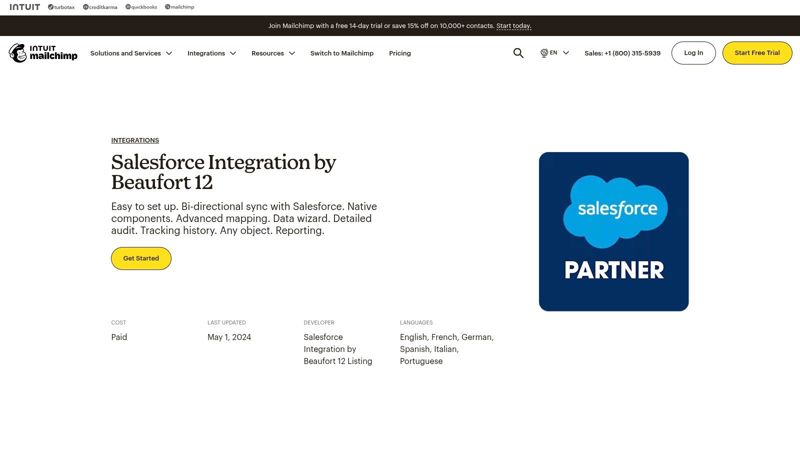
Use Cases:
- Lead Nurturing: Automatically add new Salesforce leads to targeted Mailchimp email sequences for nurturing and qualification.
- Targeted Campaigns: Segment Salesforce contacts based on demographics, purchase history, or other custom fields, and create highly targeted Mailchimp email campaigns.
- Closed-Loop Reporting: Track the impact of Mailchimp campaigns on Salesforce opportunities and revenue, demonstrating the ROI of email marketing efforts.
- Improved Sales Follow-up: Sales teams can view contact email engagement within Salesforce, enabling more timely and relevant follow-up communication.
- Event Management: Synchronize event attendees between Salesforce and Mailchimp to manage invitations and follow-up communications.
Features:
- Bi-directional contact and lead synchronization
- Campaign performance tracking in Salesforce
- Email engagement metrics on contact records
- Automated list management based on CRM data
- Custom field mapping capabilities
Pros:
- Enterprise-grade reliability and security
- Comprehensive view of customer journey
- Supports complex B2B sales processes
- Works with Salesforce Pardot for advanced marketing automation
Cons:
- Requires Salesforce paid license
- Complex setup and configuration
- May require developer assistance for custom configurations
- Additional cost for Mailchimp for Salesforce app ($50-$300/month)
Pricing and Technical Requirements:
A paid Salesforce license is required. The Mailchimp for Salesforce app has a tiered pricing structure ranging from $50 to $300 per month, depending on the features and number of contacts. While the basic setup can be handled by a marketing automation specialist, more complex configurations, especially involving custom objects and fields, may require developer assistance.
Implementation Tips:
- Plan your data mapping carefully: Clearly define which fields need to be synchronized between Salesforce and Mailchimp.
- Start with a small test group: Before syncing your entire database, test the integration with a smaller subset of contacts to identify and resolve any issues.
- Document your configuration: Keep a record of your field mappings and other configuration settings for future reference and troubleshooting.
- Consider professional assistance: If you have complex requirements or lack in-house Salesforce expertise, consider engaging a certified Salesforce consultant to assist with the setup and configuration.
Comparison with Similar Tools:
While other email marketing platforms offer Salesforce integrations, the Mailchimp integration stands out for its user-friendliness and affordability, making it a suitable option for businesses of all sizes. However, if your business requires more advanced marketing automation capabilities, tools like Pardot (which integrates directly with Salesforce) might be a better fit, albeit at a higher price point.
Website: https://connect.mailchimp.com/integrations/salesforce
This integration earns its place on our list due to its robust features, ability to streamline marketing and sales processes, and its potential to significantly improve the customer journey. By leveraging the combined power of Salesforce and Mailchimp, businesses can achieve greater marketing efficiency and drive better business outcomes.
7. Gravity Forms Mailchimp Add-On
For WordPress users seeking robust Mailchimp integrations, the Gravity Forms Mailchimp Add-On offers a direct and powerful solution. This official extension bridges the gap between your WordPress forms and your Mailchimp audience, automating list building and streamlining your marketing workflow. It allows you to seamlessly connect form submissions to your Mailchimp lists, opening up a world of marketing automation possibilities directly within your WordPress environment. This makes it a particularly attractive option for businesses heavily reliant on their WordPress website for lead generation.
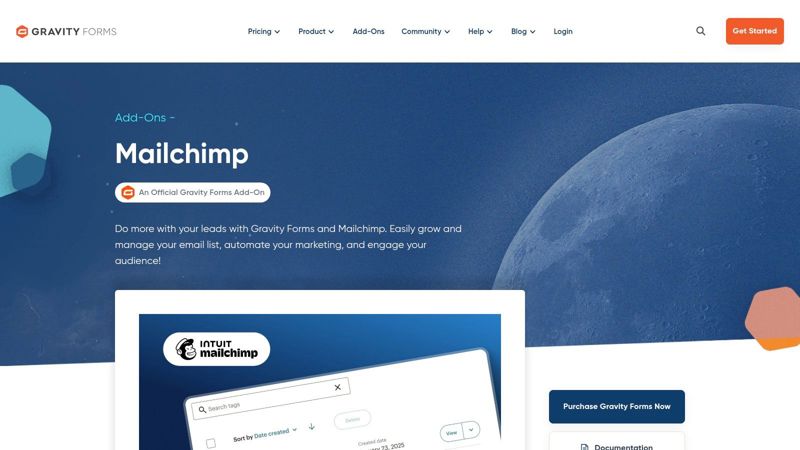
Imagine a potential customer filling out a contact form on your website. With this add-on, that information isn't just stored in your WordPress database; it's instantly sent to your designated Mailchimp list. This allows you to trigger welcome emails, nurture campaigns, or even segment users based on their form responses. For example, a real estate agent could use this to automatically add leads to different lists based on the type of property they're interested in, allowing for highly targeted follow-up communication. Similarly, event organizers can segment attendees based on ticket type or workshop selections directly from their registration forms. This kind of granular control makes the Gravity Forms Mailchimp Add-On a valuable asset for targeted marketing efforts.
The add-on boasts features like direct form-to-list mapping, custom field synchronization for personalized messaging, and conditional logic for sophisticated list segmentation. It also supports Mailchimp groups and tags, offering even finer control over audience organization. Double opt-in configuration options ensure GDPR compliance and maintain a high-quality subscriber list. For those comfortable working within the WordPress ecosystem, the setup is straightforward, leveraging the familiar Gravity Forms interface.
Key Features and Benefits:
- Direct Form-to-List Mapping: Easily connect specific forms to designated Mailchimp lists.
- Custom Field Mapping: Map form fields to corresponding Mailchimp fields to personalize your email campaigns.
- Conditional Logic: Add subscribers to different lists based on their form responses, enabling targeted campaigns.
- Mailchimp Groups and Tags: Utilize Mailchimp's organizational features for even more precise segmentation.
- Double Opt-in Configuration: Ensure GDPR compliance and maintain a clean subscriber list.
Pros:
- Tight WordPress Integration: Seamlessly integrates within the WordPress environment.
- No Third-Party Dependencies: Avoid relying on external services for the integration.
- Versatile Form Compatibility: Works with any Gravity Forms form type.
- Reliable Compatibility: Built by Gravity Forms, ensuring maximum compatibility and support.
Cons:
- Gravity Forms License Required: Requires an active Gravity Forms license ($59-$259/year).
- WordPress Specific: Limited to WordPress websites.
- Basic Automation: Offers basic automation compared to dedicated marketing automation platforms.
- No Two-Way Sync: Data synchronization is one-way, from Gravity Forms to Mailchimp.
Website: https://www.gravityforms.com/add-ons/mailchimp/
This integration earns its spot on our list due to its tight integration with the WordPress ecosystem and its powerful automation capabilities for list building and segmentation. While the Gravity Forms license adds a cost, the streamlined workflow and potential for highly targeted campaigns make it a valuable Mailchimp integration for WordPress-based businesses. If you are already using Gravity Forms, this add-on is a no-brainer for enhancing your Mailchimp marketing strategy. If you are not currently using Gravity Forms, consider the cost-benefit analysis of implementing this powerful combination for your specific needs.
8. Shopify Mailchimp App
Reconnecting your Shopify store with Mailchimp for powerful email marketing is made possible through the Shopify Mailchimp App, a valuable tool among various Mailchimp integrations. This third-party app, developed by ShopSync, acts as a bridge between the two platforms, effectively restoring much of the functionality lost after their official partnership ended. For e-commerce businesses relying on Mailchimp for email marketing, this integration is a game-changer.
This app synchronizes vital data from your Shopify store directly to your Mailchimp account, empowering you to create highly targeted email marketing campaigns. This includes real-time customer data synchronization, ensuring your Mailchimp audience is always up-to-date. Order data and purchase history are also transferred, allowing for personalized product recommendations and post-purchase follow-ups. Furthermore, the app synchronizes your product catalog, making it easy to showcase your offerings within your email campaigns.
Practical Applications and Use Cases:
- Abandoned Cart Recovery: Automatically remind customers about items left in their carts, recovering potentially lost sales.
- Personalized Product Recommendations: Suggest products based on past purchases, increasing customer engagement and average order value.
- Purchase-Based Segmentation: Create targeted email campaigns for specific customer segments based on their purchase history (e.g., first-time buyers, repeat customers, high-value customers).
- Targeted Promotions: Deliver exclusive offers and promotions to specific customer groups, maximizing their impact.
- Post-Purchase Engagement: Send personalized thank you emails, product care instructions, or related product suggestions after a purchase.
Features and Benefits:
The Shopify Mailchimp App offers a robust set of features that streamline your email marketing efforts:
- Real-time Customer Data Synchronization: Ensures your Mailchimp audience is always current, eliminating manual imports and exports.
- Order Data and Purchase History Transfer: Enables personalized product recommendations and targeted post-purchase campaigns.
- Product Catalog Synchronization: Makes it easy to feature products in your email marketing campaigns.
- Automated Abandoned Cart Recovery: Helps recover lost sales and boost revenue.
- Customer Segmentation based on Purchase Behavior: Allows for highly targeted email campaigns that resonate with specific customer groups.
Pricing and Technical Requirements:
The Shopify Mailchimp App offers tiered pricing plans ranging from $9 to $29 per month, depending on the features and number of subscribers. It requires a Shopify store and a Mailchimp account. Some advanced features may require a paid Mailchimp plan.
Pros and Cons:
Pros:
- Restores full Mailchimp functionality for Shopify stores.
- Quick and easy setup with minimal configuration.
- Reliable data synchronization.
- Regular updates and dedicated support.
Cons:
- Third-party app (not officially from Shopify or Mailchimp).
- Monthly subscription cost.
- Some advanced features require Mailchimp paid plans.
- Limited customization options compared to a direct API integration.
Implementation/Setup Tips:
Installation is straightforward through the Shopify App Store. Once installed, simply connect your Mailchimp account and configure the desired synchronization settings. The app provides a user-friendly interface for managing your integration.
Comparison with Similar Tools:
While other Mailchimp integrations exist for Shopify, the Shopify Mailchimp App stands out due to its comprehensive features specifically designed for e-commerce email marketing. It provides a more robust solution compared to basic email capture forms or less feature-rich integrations.
Why This Integration Deserves Its Place on the List:
For e-commerce businesses using Shopify and seeking a reliable and efficient way to leverage Mailchimp’s powerful email marketing capabilities, the Shopify Mailchimp App provides a vital connection. Its automated features, real-time synchronization, and focus on customer segmentation make it an essential tool for maximizing sales and enhancing customer relationships.
Website: https://apps.shopify.com/shopify-mailchimp-connector
Mailchimp Integration Tools Comparison
| Platform | Core Features & Integration ✨ | User Experience & Quality ★★★★☆ | Value & Pricing 💰 | Target Audience 👥 | Unique Selling Points 🏆 |
|---|---|---|---|---|---|
| OKZest | No-code/API image personalization; 99% ESP compatibility | Easy integration; great support; scalable | Free to enterprise; team roles included | Marketers, agencies, sales, consultants | 🏆 Personalized dynamic images at scale; team mgmt; real-time support |
| Zapier | 5,000+ app integrations; visual workflow builder | User-friendly; reliable; good monitoring | Free limited; paid from $19.99/month | General automation users, marketers | Automate workflows across many apps |
| Integromat (Make) | Advanced visual builder; data transformation; webhooks | Powerful but complex; unlimited scenarios | Free limited ops; affordable paid plans | Advanced users needing complex automations | Flexible ops; data control; cheaper than Zapier |
| HubSpot | Native bi-directional contact sync; campaign tracking | Seamless sales-marketing sync; detailed analytics | Paid HubSpot tiers required | CRM users, sales & marketing teams | Deep CRM + email marketing integration |
| WooCommerce Mailchimp Integration | eCommerce data sync; cart recovery; purchase segmentation | Real-time sync; free plugin | Free plugin; requires Mailchimp paid | WooCommerce store owners | Strong eCommerce mail integration |
| Salesforce Mailchimp Integration | Bi-directional sync; engagement metrics; custom mappings | Enterprise-grade; complex setup | Salesforce license + $50-$300/month app | Enterprise CRM users | Robust B2B pipeline integration |
| Gravity Forms Mailchimp Add-On | WordPress form to list mapping; conditional logic | Tight WP integration; limited automation | Gravity Forms license required | WordPress site owners, lead gen | Native WP forms integration |
| Shopify Mailchimp App | Customer/order sync; cart recovery; segmentation | Quick setup; reliable sync | $9-$29/month + Mailchimp plan | Shopify eCommerce stores | Restores Mailchimp-Shopify connection |
Choosing the Right Mailchimp Integrations for Your Needs
The right Mailchimp integrations can significantly enhance your email marketing efforts. From automating workflows with tools like Zapier and Integromat (Make), to syncing crucial customer data with HubSpot and Salesforce, or connecting your e-commerce platforms like WooCommerce and Shopify, the possibilities with Mailchimp integrations are vast. We’ve explored several powerful options in this article, including dedicated add-ons like the Gravity Forms Mailchimp Add-On, each offering unique advantages for different needs.
Key takeaways to remember when choosing your Mailchimp integrations include identifying your primary goals – whether it's lead generation, sales automation, or customer relationship management – and evaluating your current marketing technology stack. Consider the complexity of integration, the level of technical support offered, and the overall cost. Remember that seamless data synchronization between your platforms is paramount for personalized and targeted campaigns. The integrations you choose should streamline your workflow, not complicate it.
By carefully considering these factors, you can leverage the power of Mailchimp integrations to automate tedious tasks, personalize your messaging, and ultimately, boost your marketing ROI. Choosing the right tools will allow you to focus on what truly matters: creating compelling content and building lasting relationships with your audience.
Looking for a seamless way to integrate your forms and surveys with Mailchimp? Check out OKZest for a user-friendly solution that simplifies data capture and streamlines your email marketing automation. OKZest offers powerful integrations that empower you to effortlessly connect your forms and surveys with your Mailchimp audience, making list building and segmentation a breeze.